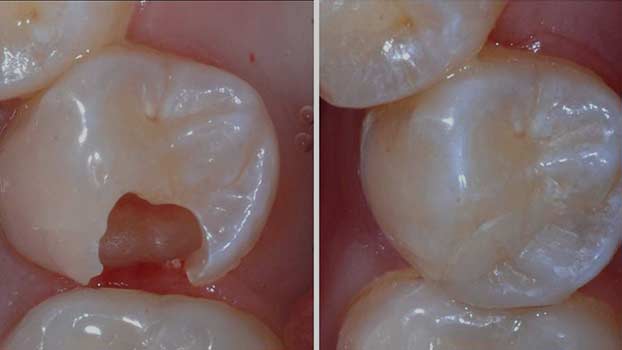There are different kinds of fillings used to restore teeth after decay is removed:
Composites
Advances in modern dental materials and techniques increasingly offer new ways to create more pleasing, natural-looking smiles. Researchers are continuing their decades-long work developing aesthetic materials, such as ceramic and plastic compounds that mimic the appearance of natural teeth. As a result, dentists and patients today have several choices when it comes to selecting materials used to repair missing, worn, damaged or decayed teeth.
Composite resins are tooth-colored materials that are used both as fillings and to repair defects in the teeth. Because they are tooth-colored, it is difficult to distinguish them from natural teeth. Composites are often used on the front teeth where a natural appearance is important. They can be used on the back teeth as well depending on the location and extent of the tooth decay.
Cements
Ionomers – Glass ionomers are tooth-colored materials made of a mixture of acrylic acids and fine glass powders that are used to fill cavities, particularly those on the root surfaces of teeth. Glass ionomers can release a small amount of fluoride that help patients who are at high risk for decay. Glass ionomers are primarily used as small fillings in areas that need not withstand heavy chewing pressure. Because they have a low resistance to fracture, glass ionomers are mostly used in small nonload-bearing fillings (those between the teeth) or on the roots of teeth. Resin ionomers also are made from glass filler with acrylic acids and acrylic resin. They also are used for nonload-bearing fillings (between the teeth) and they have low to moderate resistance to fracture. Ionomers experience high wear when placed on chewing surfaces. Both glass and resin ionomers mimic natural tooth color but lack the natural translucency of enamel. Both types are well tolerated by patients with only rare occurrences of allergic response.
Porcelain (ceramic) dental materials
All-porcelain (ceramic) dental materials include porcelain, ceramic or glasslike fillings and crowns. They are used as inlays, onlays, crowns, and aesthetic veneers. A veneer is a very thin shell of porcelain that can replace or cover part of the enamel of the tooth. All-porcelain (ceramic) restorations are particularly desirable because their color and translucency mimic natural tooth enamel. All-porcelain restorations require a minimum of two visits and possibly more. Their strength depends on an adequate thickness of porcelain and the ability to be bonded to the underlying tooth. They are highly resistant to wear but the porcelain can quickly wear opposing teeth if the porcelain surface becomes rough.
